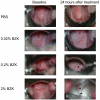High resolution imaging of epithelial injury in the sheep cervicovaginal tract: a promising model for testing safety of candidate microbicides
- PMID: 19295469
- PMCID: PMC2675633
- DOI: 10.1097/OLQ.0b013e31819496e4
High resolution imaging of epithelial injury in the sheep cervicovaginal tract: a promising model for testing safety of candidate microbicides
Abstract
Background: Access to readily available large animal models and sensitive noninvasive techniques that can be used for the evaluation of microbicide-induced changes in tissue could significantly facilitate preclinical evaluations of microbicide safety. The sheep cervicovaginal tract, with stratified squamous epithelium similar to humans, holds promise as a large animal model used before nonhuman primates. In addition, optical coherence tomography (OCT) could enable high resolution visualization of tissue morphology and noninvasive assessment of microbicide-induced epithelial injury.
Methods: We evaluated the dose response of sheep cervicovaginal tract to benzalkonium chloride (BZK). Twenty sheep received treatment with phosphate-buffered saline or BZK solution (2%, 0.2%, or 0.02%). Pre- and posttreatment colposcopy and OCT images were collected and graded based on World Health Organization criteria and a previously reported scoring system, respectively. Biopsies were collected and the degree of epithelial injury and its thickness was assessed based on histology and OCT.
Results: The sheep cervicovagina exhibited anatomic and microscopic features similar to the human. Extensive loss of the epithelium was noted on colposcopy and OCT after application of 2% BZK. Colposcopy detected findings in half of sheep and OCT in all sheep treated with 0.2% BZK. OCT detected differences in the 0.02% BZK-treated group compared with controls, whereas colposcopy failed to detect any changes.
Conclusions: The sheep cervicovagina is similar to humans, and exhibits dose dependent epithelial changes after BZK treatment. These findings suggest that the sheep model and OCT may become valuable tools for the safety evaluation of candidate microbicides, and warrant continued development.
Figures





References
-
- WHO. CONRAD . Technical Consultation on Nonoxynol-9.Conrad. World Health Organization; Geneva: 2001. - PubMed
-
- Van Damme L, Ramjee G, Alary M, et al. Effectiveness of COL-1492, a nonoxynol-9 vaginal gel, on HIV-1 transmission in female sex workers: a randomised controlled trial. The Lancet. 2002:971–977. - PubMed
-
- Kreiss J, Ngugi E, Holmes K, et al. Efficacy of nonoxynol-9 contraceptive sponge use in preventing heterosexual acquisition of HIV in Nairobi prostitutes. JAMA. 1992;268:477–482. - PubMed
-
- Zekeng L, Feldblum PJ, Oliver RM, et al. Barrier contraceptive use and HIV infection among high-risk women in Cameroon. AIDS. 1993;7:725–31. - PubMed
Publication types
MeSH terms
Substances
Grants and funding
LinkOut - more resources
Full Text Sources
Other Literature Sources
Medical

